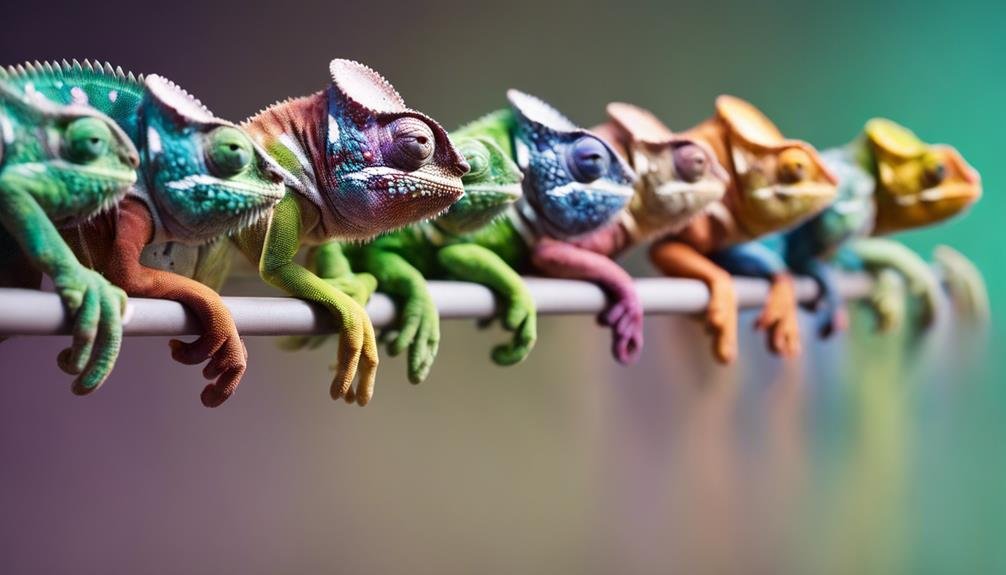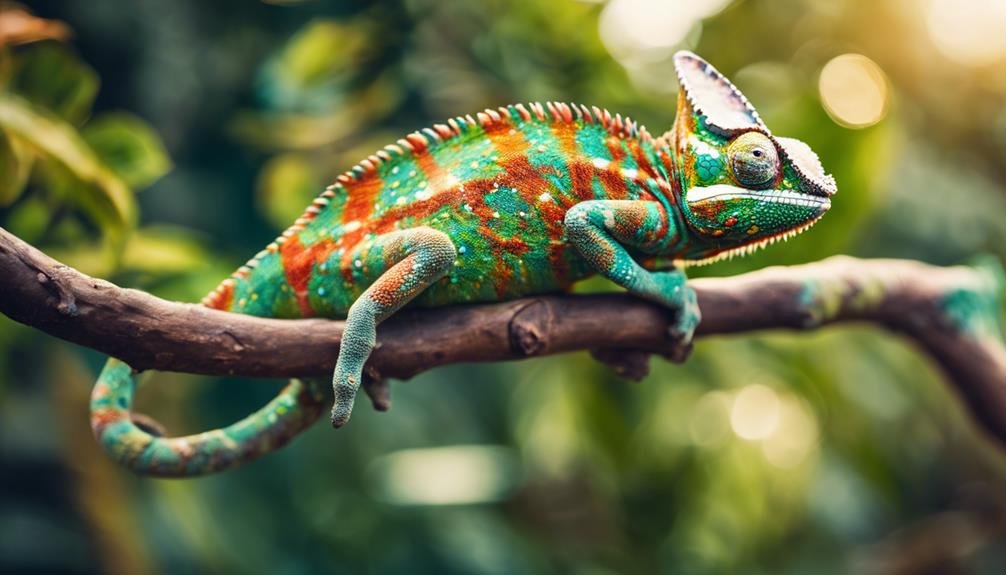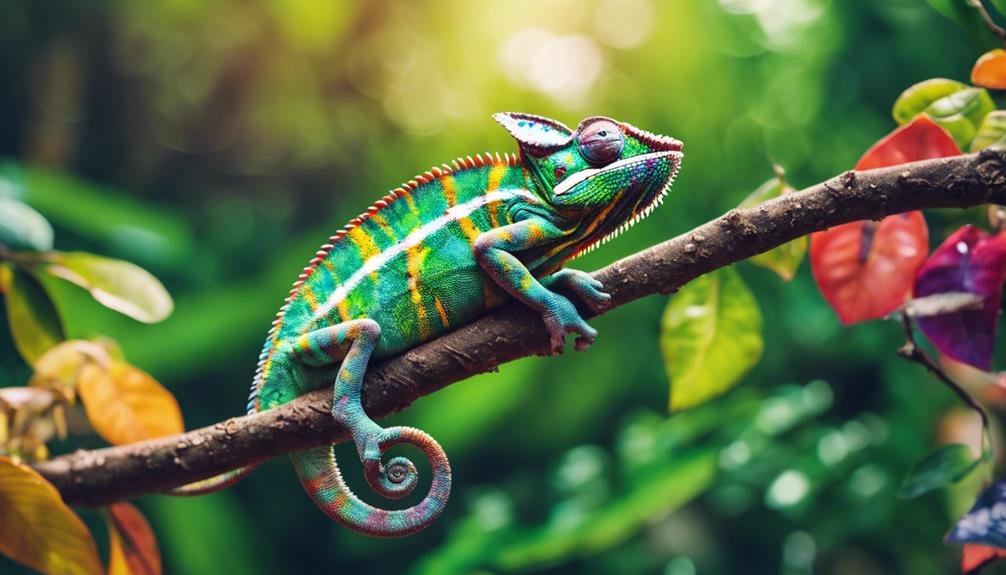Have you ever wondered how much you’d have to shell out for a chameleon? The prices can vary widely, with factors such as species, age, and rarity playing major roles. For instance, a standard Veiled Chameleon might set you back about $30, but if you’re eyeing a more exotic Panther Chameleon, be prepared to spend upwards of $300. Now, you might think that’s all there is to it, but the initial cost is just the beginning. What about the ongoing expenses for care? Stick around, and we’ll explore just how deep the financial commitment can get when you choose to bring one of these colorful creatures into your home.
Key Takeaways
- Veiled chameleons range from $36.99 for females to $119.99 for rare pairs.
- Madagascar Panther Chameleons start at $319.00, reflecting their rarity.
- Rainbow Jackson Chameleons are moderately priced at $94.95.
- Nosy Be Panther Chameleons begin at $279.00 due to unique traits.
- Costs vary by species, age, color morph, and rarity of the chameleon.
Initial Costs of Chameleons
When you’re thinking about buying a chameleon, the initial costs can vary greatly depending on the species, age, gender, and specific color morph you choose. If you’re leaning towards Veiled chameleons, the prices reflect this diversity. For instance, a female might set you back $36.99, whereas if you’re interested in a pair of baby Veiled chameleons, you’ll need to budget around $79.00. These figures can jump significantly for certain color morphs. The Low White Piebald Veiled chameleons, a more unique variety, are priced at $59.99 for females and $119.99 for a pair.
Moving on to other species, a Medium Female Ambilobe Panther Chameleon, known for their striking colorations, commands a price of $229.99. These variations highlight how chameleon prices aren’t just about the species but also reflect the age and gender. A Sub Adult Female Veiled chameleon, for instance, is available for $49.99 each.
Understanding these initial costs is important as you decide which chameleon is right for you. Factors like age, gender, and color morph play important roles in determining the price, ensuring you need to think about what fits your preferences and budget before making a purchase.
Ongoing Care Expenses
How do you manage the recurring costs of maintaining a chameleon’s health and habitat?
The ongoing care expenses for your chameleon revolve around several key areas. First, you’ll need to regularly invest in habitat setup. This includes proper lighting and heating to mimic their natural environment, which is important for their health and well-being.
Feeder insects such as Dubia Roaches, crickets, and mealworms form the core of a chameleon’s balanced diet. You’ll need to budget for these expenses monthly, as a varied diet is essential. Additionally, supplements like calcium and vitamins are necessary to prevent health issues and will be a regular part of your shopping list.
Don’t forget vet check-ups, which are crucial to make sure your chameleon remains healthy and receives care for any potential issues early. These visits can vary in frequency based on your pet’s health but anticipate at least annual check-ups.
You’ll also need to take into account the cost of cleaning supplies to maintain a hygienic environment for your chameleon. Over time, accessories within the habitat may wear out and need replacement, such as climbing branches, leaves, or even the enclosure itself. Managing these ongoing costs effectively will ensure your chameleon leads a healthy, happy life.
Price Differences by Species


Chameleon prices vary greatly by species, with factors like coloration and size influencing the cost. You’ll find that more exotic species such as the Madagascar Panther Chameleons and Ambilobe Panther Chameleons are priced at a premium due to their striking colorations and rarity. On the other hand, more common species like the Veiled Chameleon and False Chameleons are more affordable but still offer a range of colorations and sizes.
Here’s a quick look at starting prices for different species to help you navigate the price variations:
| Chameleon Species | Starting Price (USD) |
|---|---|
| Veiled Chameleon | $59.00 |
| Madagascar Panther Chameleons | $319.00 |
| Rainbow Jackson Chameleons | $94.95 |
| False Chameleons | $59.95 |
| Nosy Be Panther Chameleons | $279.00 |
| Oustalets Chameleons | $79.00 |
| Ambilobe Panther Chameleons | $319.00 |
As you can see, the price variations can be significant, especially between simpler and more intricate species. Whether you’re drawn to the Nosy Be Panther Chameleons for their unique hues or the larger Oustalets Chameleons, there’s a chameleon to fit both your budget and aesthetic preferences.
Impact of Age and Size
Age and size significantly affect a chameleon’s price, with adults often costing more than their younger counterparts. When you’re choosing a chameleon, it’s important to think about not just the initial price but also how the age and size influence the long-term costs of care. Younger chameleons might seem like a bargain at first, but they often require more frequent feeding and might need different husbandry parameters as they grow. This can add up over time.
On the other hand, adults, particularly larger ones or breeding pairs, command a higher price. These chameleons are usually more established, potentially easier to handle, and less susceptible to stress-related issues common in juveniles. However, their care, including their diet and habitat needs, can be more demanding given their size and reproductive status.
Also, the species and specific color morph of the chameleon can influence the price. Rare species or those with unusual color patterns are typically priced higher. When you’re weighing your options, remember that the cost of a chameleon isn’t just about the purchase price; it’s also about the commitment to proper care throughout the reptile’s life.
Does the Price of a Chameleon Affect Its Ability to Change Color?
The price of a chameleon does not affect its ability to change color. The reasons for color change in chameleons are due to their mood, environment, and temperature. These factors trigger the chameleon to adjust its color to blend in or communicate with other chameleons.
Rare and Designer Morphs Costs


If you’re eyeing a rare or designer morph, expect to pay anywhere from $59.95 to $319.00, depending on the specific traits and rarity of the chameleon. This price range reflects the unique characteristics and striking coloration that these exotic pets can offer.
Here’s a breakdown of what you might find:
- Madagascar Panther Chameleons: Starting at $319.00, these chameleons are prized for their vivid colors and dynamic patterns. They’re at the top of the price spectrum due to their rarity and high demand.
- Nosy Be Panther Chameleons: These start at $279.00 and are known for their stunning blue coloration. They’re a favorite among collectors who seek distinct morph characteristics.
- Veiled Chameleons: Originally priced at $110.00, these can now be snagged for as low as $59.00. They offer an affordable entry into the world of chameleons while still showcasing impressive features.
- Oustalets Chameleons: Available from $79.00, these are less common and provide a unique option for enthusiasts interested in less conventional species.
Conclusion
When you’re looking to buy a chameleon, keep in mind that prices can vary widely. You might spend as little as $37 for a basic Veiled Chameleon or over $300 for a Madagascar Panther Chameleon. The cost often increases with rare morphs and older, breeding-ready chameleons.
Don’t forget to budget for ongoing care too, which includes food, habitat, and vet visits. Choose wisely based on your budget and preferences to guarantee a happy and healthy pet.


